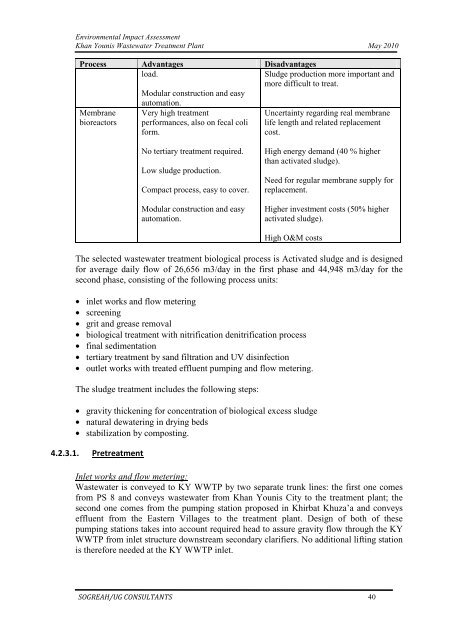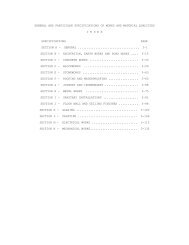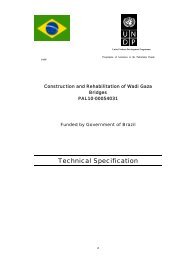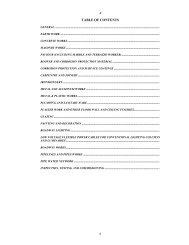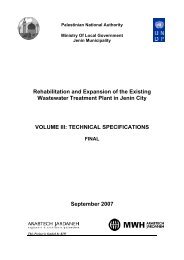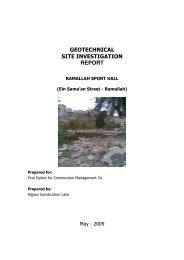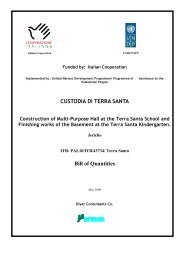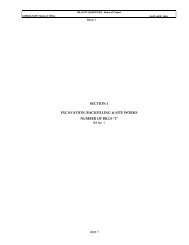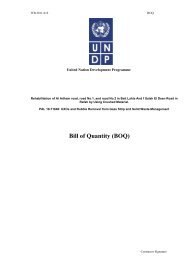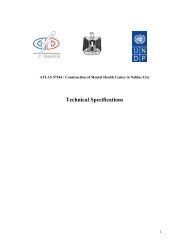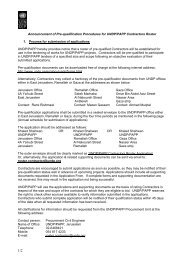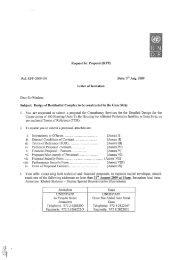EIA Study- Final Report-May 10 - UNDP
EIA Study- Final Report-May 10 - UNDP
EIA Study- Final Report-May 10 - UNDP
Create successful ePaper yourself
Turn your PDF publications into a flip-book with our unique Google optimized e-Paper software.
Environmental Impact Assessment<br />
Khan Younis Wastewater Treatment Plant <strong>May</strong> 20<strong>10</strong><br />
Process Advantages Disadvantages<br />
load.<br />
Sludge production more important and<br />
more difficult to treat.<br />
Modular construction and easy<br />
automation.<br />
Membrane<br />
bioreactors<br />
Very high treatment<br />
performances, also on fecal coli<br />
form.<br />
Uncertainty regarding real membrane<br />
life length and related replacement<br />
cost.<br />
No tertiary treatment required.<br />
Low sludge production.<br />
Compact process, easy to cover.<br />
Modular construction and easy<br />
automation.<br />
High energy demand (40 % higher<br />
than activated sludge).<br />
Need for regular membrane supply for<br />
replacement.<br />
Higher investment costs (50% higher<br />
activated sludge).<br />
High O&M costs<br />
The selected wastewater treatment biological process is Activated sludge and is designed<br />
for average daily flow of 26,656 m3/day in the first phase and 44,948 m3/day for the<br />
second phase, consisting of the following process units:<br />
• inlet works and flow metering<br />
• screening<br />
• grit and grease removal<br />
• biological treatment with nitrification denitrification process<br />
• final sedimentation<br />
• tertiary treatment by sand filtration and UV disinfection<br />
• outlet works with treated effluent pumping and flow metering.<br />
The sludge treatment includes the following steps:<br />
• gravity thickening for concentration of biological excess sludge<br />
• natural dewatering in drying beds<br />
• stabilization by composting.<br />
4.2.3.1. Pretreatment<br />
Inlet works and flow metering:<br />
Wastewater is conveyed to KY WWTP by two separate trunk lines: the first one comes<br />
from PS 8 and conveys wastewater from Khan Younis City to the treatment plant; the<br />
second one comes from the pumping station proposed in Khirbat Khuza’a and conveys<br />
effluent from the Eastern Villages to the treatment plant. Design of both of these<br />
pumping stations takes into account required head to assure gravity flow through the KY<br />
WWTP from inlet structure downstream secondary clarifiers. No additional lifting station<br />
is therefore needed at the KY WWTP inlet.<br />
SOGREAH/UG CONSULTANTS 40


